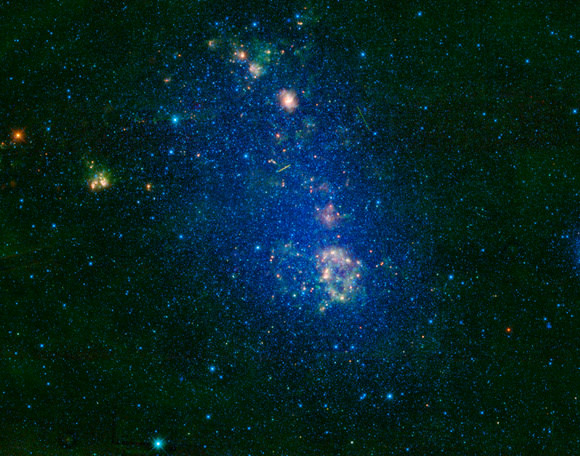[/caption]
NASA’s Wide-field Infrared Survey Explorer, or WISE, is losing its cool. The spacecraft is running out of the frozen coolant needed to keep its heat-sensitive instrument chilled, and will only be in operation for 2-3 more months. While the spacecraft was designed to be rather short-lived – 7 to 10 months — it still is sad to see the mission winding down. But WISE has completed its primary mission, a full scan of the entire sky in infrared light, which was accomplished by July 17, 2010. The mission has taken more than 1.5 million snapshots so far, uncovering hundreds of millions of objects, including asteroids, stars and galaxies. It has discovered more than 29,000 new asteroids to date, more than 100 near-Earth objects and 15 comets.
The telescope has two coolant tanks that keep the spacecraft’s normal operating temperature at 12 Kelvin (minus 438 degrees Fahrenheit). The outer, secondary tank is now depleted, causing the temperature to increase. One of WISE’s infrared detectors, the longest-wavelength band most sensitive to heat, stopped producing useful data once the telescope warmed to 31 Kelvin (minus 404 degrees Fahrenheit). The primary tank still has a healthy supply of coolant, and data quality from the remaining infrared detectors remains high.
WISE is continuing a second survey of about one-half the sky as originally planned. It’s possible the remaining coolant will run out before that scan is finished. Scientists say the second scan will help identify new and nearby objects, as well as those that have changed in brightness. It could also help to confirm oddball objects picked up in the first scan.
NASA is hoping to find more Near Earth Objects with WISE’s remaining days of operations.
“WISE’s prime mission was to do an infrared background map,” said Lindley Johnson, program executive for the Near-Earth Objects Observation program at NASA, speaking at a workshop this week to define objectives for exploring asteroids. “But we realized in talking with scientists that it would also make a good asteroid detector by comparing images. It has done a good job of finding a lot of objects for us.”
Source: NASA

